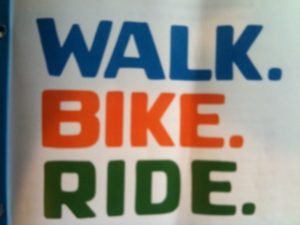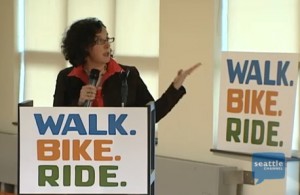If you aren’t driving a car on Seattle’s streets, you don’t feel very comfortable. That pretty much sums up the prevailing sentiment at Mayor Mike McGinn’s first gathering on the Walk.Bike.Ride initiative yesterday at Yesler Community Center.
People feel out of place at best and unsafe at worst on the city’s streets. Pedestrians, bicyclists, the disabled, parents with kids or pets — all feel marginalized, or second-class citizens, in corridors which may lack sidewalks, wheelchair access, crosswalks, bike lanes and on down the line.
“We’ve got a lot of work to do moving forward,” McGinn understated. “It’s going to take a lot of work by people who believe in this to help us move our city to a different place.” Already battle lines are being drawn on just one of the mayor’s target streets — Nickerson. Support and opposition groups are popping up over the notion of a “road diet” to improve safety, and “angry drivers” are up in arms that they might have to share the road with other users.
 To his credit, the mayor seems game for the challenge. Preceding an engaging panel skillfully moderated by Seattle Channel’s C.R. Douglas, McGinn noted that the city is accelerating implementation of its bike master plan, updating its transit master plan, and examining funding options — meaning difficult political choices involving highway mega-projects.
To his credit, the mayor seems game for the challenge. Preceding an engaging panel skillfully moderated by Seattle Channel’s C.R. Douglas, McGinn noted that the city is accelerating implementation of its bike master plan, updating its transit master plan, and examining funding options — meaning difficult political choices involving highway mega-projects.
To get all of Seattle behind a new path, the mayor is broadening the scope of the initiative to address health (obesity), affordability (equity) and diversity. As does the recently formed Streets For All Seattle coalition, the city seeks to coalesce a New Seattle emerging in the 21st Century around a different vision of how to get around.
It will involve “placemaking” — the kind of environment that cultivates street life — and “more affordable” travel choices via bus and rail. It will also prioritize right-of-way for non-car transportation — feet, pedals and wheelchairs.
The ultimate question, as Seattle Department of Transportation manager of policy and planning Barbara Gray put it, is “What would it take in your neighborhood (to) get you to walk, bike and take transit for more of your trips?”
As we’ve noted before, McGinn likes to point out that moving ahead on alternatives to a car-dependent future would cost a fraction of the billion-dollar price tags associated with the Deep Bore Tunnel and 520 Interchange projects. Tilting at those windmills means taking on powerful Olympia and downtown Seattle interests — but then, that’s what Seattleites elected him to do.
Only a few dozen persons attended the Yesler session, which will be followed by four June meetings around the city. But they all fell into the category of engaged citizenry, asking thoughtful questions that represented significant constituencies in the city. This is not really a game of head counts anyway: Lobbyists don’t influence by their feet but with their checkbooks. Last night’s collection had a passion for the life of the city that cannot be measured in dollars and cents.
Part of altering the landscape will involve education. There needs to be clarity on what works, and doesn’t work, regarding making streets more hospitable.
Perhaps the biggest myth to rear its head last night was the notion that putting more pedestrians and cyclists into the mix means more danger, leading to more accidents.
Douglas asked: “As we’ve created more bike lanes and unfolded the Bike Master Plan, are there more bike accidents because we’re actually encouraging it on more routes?”
Unfortunately, Ed Ewing of the Cascade Bicycle Club didn’t have the data point to respond. “I don’t know how many more accidents there are per se,” he said, “I just know it’s an unfortunate part of using the roads here.”
For the cycling community, this is a crucial stat, because it’s counter-intuitive. As Ewing’s fellow panelist Anne Vernez Moudon, a U.W. professor of architecture and urban design, helpfully jumped in to clarify: “If you look at the research it’s pretty clear that the more people you have walking around, the more people you have biking around, at a certain point you have a drop in the number of collisions between cars and people.” She used the example of Pike Place, where cars move slowly simply because there are so many people around.
The most notable case in point is none other than New York City, not what one would think of as the most bike-friendly place in the world. As bike ridership has gone up, the number of bike-car accidents has dropped.
The safety in numbers factor is worth emphasizing as well for people like Seattle’s favorite transit user, Carla Saulter the “Bus Chick.” Even after taking a cycling safety class from Cascade Bicycle Club, Saulter told the gathering she feels too scared to ride a bike in the city.
“I need a bike path or something,” she said.
We were also taken aback by Douglas’ assertion that “we think of bicycling as a more elite sport, an elite activity and a white activity.” Granted C.R. likes to play the devil’s advocate. But the question feeds a persistent myth. In Seattle cycling may indeed be a white activity. But Seattle is awfully white. In the Bay Area, where we live part of the year, biking is far more diverse.
We’d like to see statistics on bike use for transportation (not recreation), correlated by ethnic group. If there is disparity, we suspect it’s not because of barriers to entry but due to role modeling. Minorities see baseball, basketball and football players with the big bucks, not bike riders. (Ironically, professional cycling in Europe was traditionally considered a way to get off the farm.)
“It’s expensive just to buy a bike!” Douglas declared. While fancy bikes certainly can run up the ka-ching, on Craigslist or at a yard sale you can get a pretty serviceable used bike for less than $100. At Gregg’s Cycles you can buy a good new bike for less than $500. If properly maintained, any bike costs less than $100 a year to operate.
This compared to the $9,500 that it takes to operate a family car annually.
Elitist … unsafe … expensive. If these misconceptions are allowed to persist, the middle part of Walk.Bike.Ride won’t get to the first intersection.
Multiple other mythologies were voiced, and exploded, over the course of the discussion. My favorite was the one where parents worried about unsafe streets confine their kids indoors, where they go onto the Internet. The Net, of course, is where the majority of child predation flourishes.

In response to our query, Gray said the city continues to look at measures to reduce speed. Hey Barbara — 20 m.p.h. Check it out:
“A survey by the Transport Research Laboratory of 20 mph zones across the UK and in other European countries found child road accidents fell by 67 percent, cyclist accidents by 29 percent and traffic flow by 27 percent.”
To the extent they represent prima facie arguments against alternative street use to cars, Douglas’ questions were on point. If anything, they show how entrenched prejudices are. “Safe streets” backers have the passion and the will to overcome unfounded myths; arming themselves with pertinent data will help as well.
If last night’s session is any indication, June’s community meetings in Bitter Lake, South Seattle, West Seattle and Northgate will provide a rousing start to the city’s streets campaign. Social networking tools via Twitter, Facebook and crowd-sourcing hopefully will come into play as well. Ultimately, the sell job for Walk.Bike.Ride will have to be done by the public through the public in open forums — not in the cloistered backrooms of City Hall.
Below: See the full video of the Health, Equity and Transportation forum.

“What would it take in your neighborhood (to) get you to walk, bike and take transit for more of your trips?”
In my experience, cycling excuses are all over the map — weather, age, health, distance, etc. But only one really gets to the core: safety. When cities can solve the safety problem, they’ll have cyclists oozing out of their pores.
Dear Bike Intelligencer:
My name is Tim Nagae from Community Television Network, Ann Arbor, Michigan. We produce a local TV show called, “Eco Sense,” which is about energy and environment. The next Eco Sense show will feature the issues of walking and biking with panelists, Eli Cooper of the City of Ann Arbor’s Transportation Specialist and Nancy Shore of the Ann Arbor GetDowntown Program. We have just made a short video, “Why Bike & Walk,” promoting biking and walking activities in town, which will be used during this studio show. The following link is that video that the Ann Arbor Energy Office has just posted.
http://www.youtube.com/watch?v=ZLs_XuRMaTM
I am sending you this video in case you are interested in watching it. I hope you enjoy this video. Thank you.
Tim